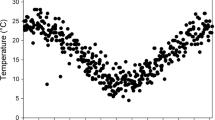Abstract.
For a short-lived organism, such as a freshwater zooplankter, the ways of coping with years of local recruitment failure are either to disperse between habitats and recolonise or to disperse in time through diapause. Diapause is common among freshwater zooplankton and is generally seen as a way to escape periods of harsh environmental conditions. The egg-bank or pool of diapausing copepodites in lake sediments resulting from the production of diapausing stages has several implications for zooplankton ecology, genetics, and evolution which we outline in this review. The presence of a benthic dormant stage also creates a coupling between the benthic habitat and the pelagic, and we argue that zooplankton phenology is a result of selective forces in both habitats. The spatial distribution of diapausing eggs appears to be governed by random resuspension dynamics coupled with higher hatching rates in shallow waters. For diapausing copepodites, however, an active choice of where and how deep to enter the sediment may affect their distribution. In a reanalysis of published data, we found a size-dependent bathymetric distribution and vertical distribution in the sediment of diapausing cyclopoid copepodites. Our review of published laboratory studies showed that predictors of seasonal change such as photoperiod and temperature were the only type of cues used for the termination of diapause. We also found a relation between generation length and the type of cue used for diapause induction: copepods mainly used seasonal cues from the abiota, rotifers mainly used cues from the biotic environment, and cladocerans used a mix of both types. We describe patterns in emergence timing and contribution to population dynamics from studies using in situ estimation of emergence, and conclude that hatching from dormant stages may qualitatively and quantitatively affect zooplankton population dynamics and seasonal succession.
Similar content being viewed by others
Author information
Authors and Affiliations
Corresponding author
Additional information
Received: 18 August 2003; revised manuscript accepted: 12 December 2003
Rights and permissions
About this article
Cite this article
Gyllström, M., Hansson, LA. Dormancy in freshwater zooplankton: Induction, termination and the importance of benthic-pelagic coupling. Aquat. Sci. 66, 274–295 (2004). https://doi.org/10.1007/s00027-004-0712-y
Issue Date:
DOI: https://doi.org/10.1007/s00027-004-0712-y




